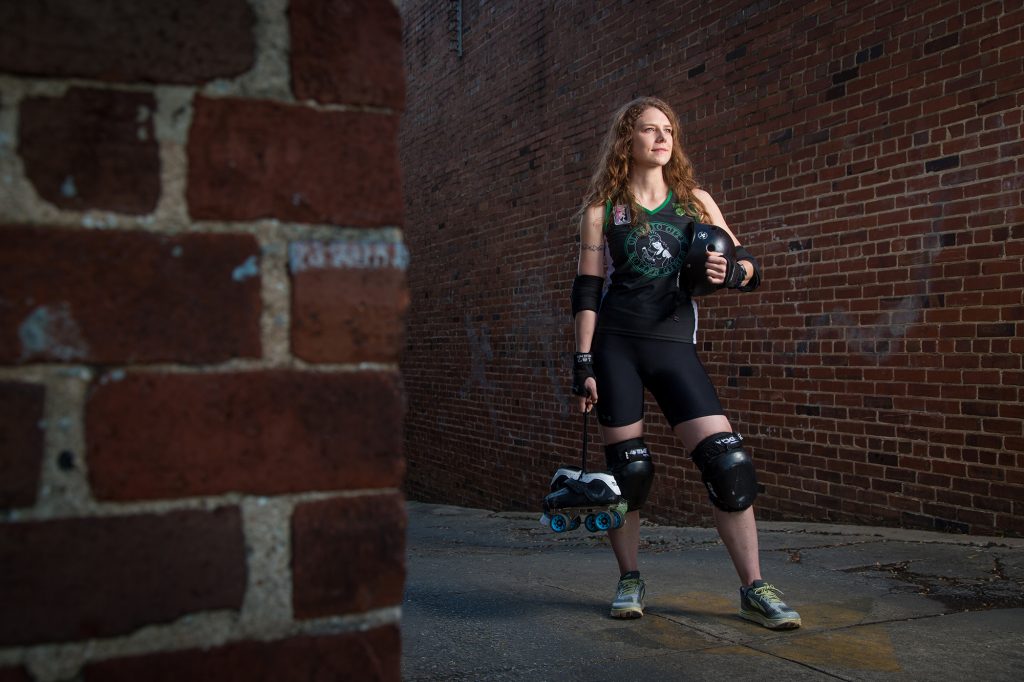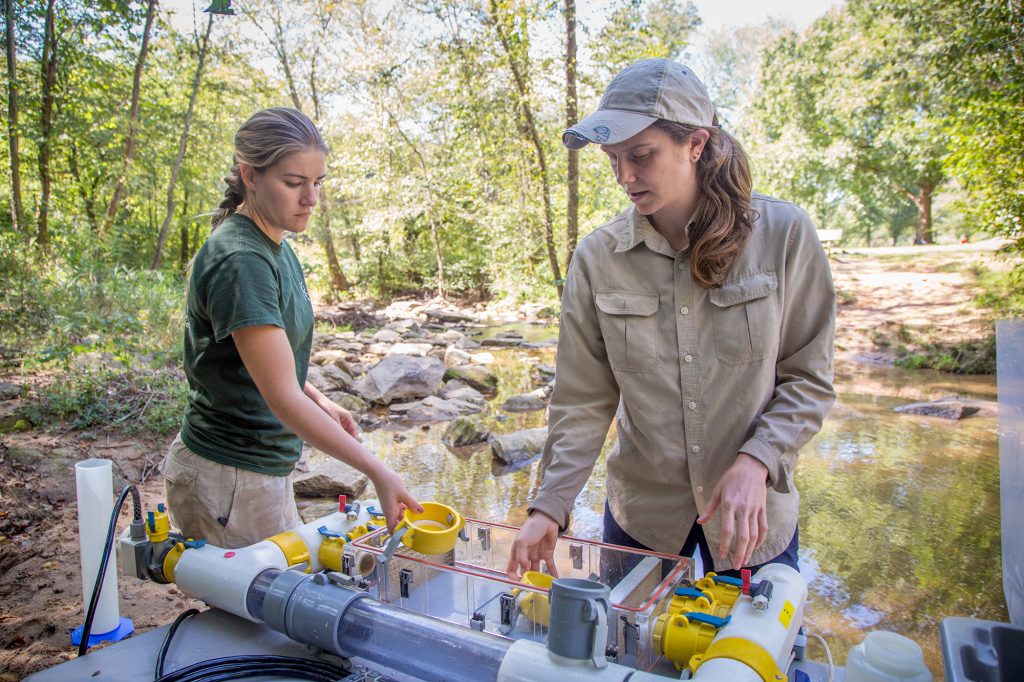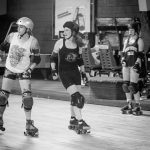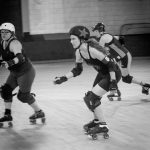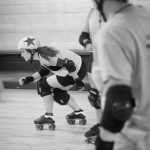Waging War on Wheels Caitlin Conn Captains the Classic City Rollergirls and Steers Them to Victory
By: Cynthia Adams | Photos By: Nancy Evelyn
“Here at Odum I am supported and mentored by an incredible group of women scientists. I have found a different type of support through derby‚ where I am challenged and lifted up by remarkable women athletes.” —Caitlin Conn
When she is on campus, doctoral student Caitlin Conn researches how changes in river flow impact ecological functions. But when she is on a different course, she studies the moves of the skaters around her, transformed by a green and black uniform and a pair of serious skates.
Caitlin Conn takes on both challenges—navigating the scientific world and the rink in roller derby—with fierce determination.
“In the early 2000s, there was resurgence of roller derby,” explains Conn. “This came largely from Texas, where they revived the old school, theatrical style of derby but with more athleticism. As the resurgence grew, most of the theatrical aspects gave way to the full-contact sport you see today played on a flat track.”
There are still many treasured oddities about the sport—for instance, punny names like Louis Strongarm and Georgia O’Greiffe—but roller derby today is an international sport.
She enjoys the sport’s odd traditions, but also bows to the practicalities associated with its physical reputation. So Conn dons a mouth guard, helmet and pads, and then takes her considerable energy to Fun Galaxy Skating Rink, where she is absorbed by an altogether different kind of flow: That of the steady skating of the Classic City Rollergirls, where she is a cocaptain for the league.
On the track, the lithe athlete is a fierce blur of sinew and muscle, known only as “Cray.” As she explains, this is a shortening of her full derby name (and more theatrical descriptor), Crazy Cait Lady.
The Arkansas native stresses there is “No fighting or brawling, but it is a full contact sport.”
Conn has skated since 2012. The Classic City Rollergirls league has only existed since 2006. Roller derby is by any standard an extreme sport: yet it attracts all types who can discharge frustrations, get a full workout, and test themselves in an entirely different way.
They are there, she explains, for the exhilaration and release of physical competition.
Roller Derby Details: The Making of a Captain
It happened by fluke that Conn ever even tried roller derby. “I started in Syracuse, New York. My partner, Elijah Carter, was getting his PhD, and I was doing conservation work with not-for-profits and state agencies,” Conn says. Conn and Carter had met years earlier while working in Costa Rica.
Conn wanted to meet some new people who weren’t academics—to broaden her scope of relationships and connect with the local community. Also athletic, she “was looking for a way to not just have graduate student friends.” Carter’s lab mate had just joined the local roller derby league and said, “I think you’re going to like this.”
An understatement, that.
Conn went to watch roller derby and liked what she saw, studying the athletic ways that “jammers wove through blockers and those blockers placed perfectly timed hits.” She was fascinated by the fact that it was all at once strategic, graceful, and fierce.
Conn liked everything about the sport from the get-go, including the community: “Roller derby leagues are usually a mix of community members, bringing together people from all walks of life—bartenders, lawyers, business owners, and students. This diverse group of women has led to a very accepting atmosphere. So while our lives and personalities may drastically differ, we all want to push ourselves, both physically and mentally, in an environment built and supported by powerful women.”
Conn had previously dabbled in martial arts, but no consistent contact sports. She hadn’t grown up as a skater. But that didn’t deter her. She found she didn’t just like the new sport. “I loved it…and its incredible community.” She transferred into the Classic City Rollergirls (Athens’ own 60+ member league) when she moved to Georgia to begin doctoral studies in ecology. Her partner, Carter, is now doing a postdoc at UGA, and while he doesn’t play himself, he couldn’t resist the sports draw either and is now the Head Referee for Classic City Rollergirls. “It has a way of drawing people in,” Conn says with a wink. “Why? You interested?”
“Here at Odum I am supported and mentored by an incredible group of women scientists; I have found a different type of support through derby, where I am challenged and lifted up by incredible women athletes.”
Classic City Rollergirls holds games, boot camps, and a year-round practice schedule as part of the Women’s Flat Track Derby Association (WFTDA)—the democratically run international organization of which they are members. The league is a registered nonprofit organization, and vies at competitions within the Southeast region.
The commitment for Conn means around nine hours of practice every week and additional hours for the behind-the-scenes work she does as part of training, captaining, and WFTDA duties. The league practices at Fun Galaxy in Athens on Monday and Wednesday evenings from 6 to 9 p.m. Then there are weekend practices targeted for both newer and veteran skaters.
The lingo of the sport indicates how much agility and physical focus it requires. “Endurance and footwork skills are where you start, and then you proceed with contact where the focus is on hitting, counter blocking and evading hits. Eventually you get to the fun stuff—scrimmage, where you must incorporate strategy and bring together all the skills you’ve learned,” says Conn.
“It’s a very structured sport. The players must learn a rule set and pass a test before competing in WFTDA-sanctioned games.” Skaters must learn the legality of hits, given roller derby is such a contact sport. “Both what you’re hitting with and what you are hitting on other people,” she explains. In other words, “both the body parts you are using to hit people with, and the areas of the body that are hit.”
Despite the fierce stereotype of roller derby competitors, Conn says “I have been fortunate to not have experienced any major injuries.” The league is systematic in how they handle injury, with specific regulations and requirements. Though minor sprains and tweaks occur, Conn says serious injuries are less common than expected.
“One of the major injuries that does occur are tibia and fibula breaks, but those are still fairly rare because we have a lot of required protective equipment: helmets, wrists, elbows and mouth guards.” The bigger worry, of course, beyond fractures is that of a head injury. Conn admits that “Many people, when they start, are tempted to lead with their head or fall backwards instead of forward onto their protective gear. If you have any impact to your head, you sit out and are assessed by a ‘safety person’ These are league members who have undergone safety training. As a WFTDA league, we are required to a have a safety person at every practice.”
“Roller Derbis always changing and progressing as a sport. I’ve seen enormous changes since I’ve been part of it, and all those changes make for fresh challenges that keep me engaged and enthralled.” – Caitlin Conn
It Isn’t Just About Skating
“We have a lot of volunteer opportunities, and the league requires quarterly participation for membership,” Conn stresses. She ticks off a few : “There are library book sales, where we assist with heavy lifting; dog walking for local animal shelters; and many more events from the relationships we have built with local companies and organizations.”
Local businesses support the league via sponsorships, as the league members must pay for all gear and training costs.
Conn realizes that many people work out physically in order to relieve stress. She is among them. “I need derby. I’ve always been active and yet wouldn’t call myself fit. I’ve cycled through activities because I get bored, but roller derby is different. It’s always changing and progressing as a sport. I’ve seen enormous changes since I’ve been part of it, and all those changes make for fresh challenges that keep me engaged and enthralled.”
A credo of good sportsmanship means pulling other skaters along towards success.
Conn says the league enables players to push fellow members towards their potential. “It brings women from all walks of life into an athletic arena where they can succeed and excel—people at all different levels. We take people who have never even skated, and they slowly but surely move up and find their role within the league. This could mean playing on our A or B team, or taking on one of our many volunteer positions, perhaps as a skating or non-skating official.”
This sense of physical empowerment is a huge reward for Conn, who watches new members’ mastery with great pride. “You get people who are literally holding onto the wall to start with progressing to playing full on roller derby on a team.”
There is the intangible aspect of watching people explore physical strengths they had never before discovered. Validation comes from becoming physically adroit.
And then, there is the sheer diversity of types of people who skate with Conn’s team. “The co-captain, Cirque du Slay, is an accomplished philosophy teacher and mentor. She will be the first to tell you she progressed slowly when she started skating, and now she is our best trainer and a force to be reckoned with on the track!”
Conn has learned not to stereotype people. This serves her well both on the track and off it.
“You meet people that are reserved off the track, and yet on the track, they are total, well, bad asses,” she says with a knowing grin.
While the Classic City Rollergirls is big in spirit, Conn says they are notably a physically small league in stature. At 5’7” in height, she is among the taller people in the league.
“But we are a force to be reckoned with! We have been climbing in the ranks, moving from 181 in WFTDA international rankings at the beginning of the season to 115 currently. Our A team went 8-1 for the season, and I could not be prouder of all the work my teammates have put in to get here.”
Why does Conn believe others should consider roller derby as a sport?
“For me, it was so exciting the first time I watched it; it’s a very complex sport. The rule set is intricate, and as a scientist, I’m attracted to that intricacy. The combination of force and power with elegance… it takes patience and dedication to accomplish that.”
Conn searches for a description of the sport’s demands: “It requires agility and light-footedness in the way that skaters move while simultaneously being full contact. And there’s no ball involved, so it is all about how you use your own body and those of your teammates. Because offense and defense are played at the same time, it requires mental acuity and the ability to switch on a dime. All this complexity is both challenging and endlessly rewarding.”
Force. Power. Elegance. Thrilling adjectives, and all the more so when punctuated by the idea of a roller derby. Where else is willpower exemplified by dizzying high speeds and devil-may-care athleticism?
The Athletic Academic “For years, roller derby has been cast as the domain of the racy misfit of the hidden second life of the otherwise traditional housewife or professional,” says Caitlin Conn. “That portrayal is outdated and terribly limiting, as if women are one-dimensional creatures who are either this or that – eccentric and empowered or timid and traditional, a mousy academic or a fierce athlete,” she adds, not mincing her words.
Derring-do is not quite academic. Neither subdued nor polite.
Small wonder it would appeal to scientists like Conn. Science doesn’t accelerate at high speeds—there are excruciating trials and delays.
Which raises a question: At the end of the day, is roller derby as much about the escapism and adrenaline rush as anything?
Perhaps, Conn admits with a slow nod of the head, and that rush factors in even when sitting on the bench or in the bleachers. “Watching it, I find the sport exciting. Obviously, participating is even more so. I wouldn’t do it if I didn’t love the physical aspects of it.”
When she introduces newbies to the sport, there are many reactions. “But people are always surprised, and comment on how exciting it is. It’s so unfamiliar!”
Furthering the sports revival, roller derby is gaining a new following as championships appear on ESPN3. Their signature green and black color is easy to spot in a city that is inundated with red.
The Classic City Rollergirls ended their season in late summer when they won their final bout against Chattanooga. The 2018 competitive season begins early. According to Conn, “Our big opener will be in early February where we play ourselves: Green vs. Black. By the beginning of 2018, the Classic City Rollergirls will again go up against the biggest and best among roller derby skaters.” As of September 30th, CCRG is officially ranked as 114 (out of 335 international member leagues). “I am also now co-captain under the captain Cirque du Slay. We were equal co-captains through September, but for this upcoming season, I decided to take on a slightly lesser role as I work on my prospectus and go through comprehensive exams.”
Conn welcomes all to try out. “Playing a contact sport is a humbling and challenging experience, whether it is roller derby, rugby, or martial arts. You must recognize your limits, face your fears, and be disciplined to achieve your goals.”
Do You Have What it Takes to Become a RollerGirl?
Per their website: “You’ve been to a roller derby bout and thought, ‘I can do that.’ You’re looking for a fun, new sport that puts you hip to hip with the coolest girls in town. You’ve always wanted to participate in a full contact sport and unleash your pent up aggression. Sounds like you’re interested in waging war on wheels: time to become a rollergirl!”
And per Co-Captain Cray: “It’s such an equalizer…it strengthens and empowers women!”
Find more information about the WFTDA on their website: https://wftda.com/
NSF Award Winners Include Caitlin Conn
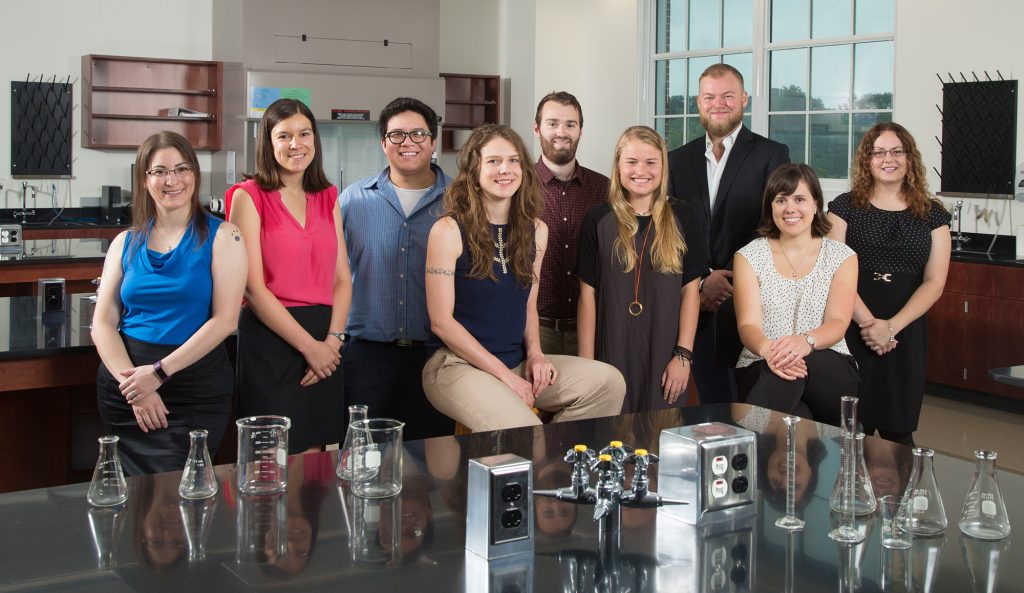
NSF (National Science Foundation) recipients: Abigail Courtney, David Vasquez, Claire Teitelbaum, Caitlin Conn, Matthew Powers, Avery Wiens, Henry Adams, Mariel Pfeifer, Elizabeth Watts
This spring, 12 students from the University of Georgia received the 2017 National Science Foundation’s Graduate Research Fellowship Program Award (GRFP). The UGA graduate students were among 2,000 recipients named nationwide.
The award recognizes and supports outstanding early career graduate students in NSF-supported science, technology, engineering, and mathematics disciplines who are pursuing research-based graduate degrees.
The UGA award winners shown left to right are: Abigail Judith Courtney, Claire Teitelbaum, David Vasquez, Caitlin Conn,Matthew Powers, Avery Wiens, Henry Adams, Mariel Pfeifer and Elizabeth Watts.
Past winners include Nobel Laureates and a host of luminaries. As the oldest fellowship of its kind, the GRFP has a long history of selecting recipients who achieve high levels of success in their future academic and professional careers.

Caitlin Conn, at left, working at a tributary of the Middle Oconee River in Athens, Ga., with UGA graduate student Emily Johnson. A doctoral student in the Odum School of Ecology, Conn measures the biomass of primary producers in the river and uses chamber studies to measure productivity and nutrient uptake. Her research examines the relationship between flow and ecological function.
“Streams process nutrients that come in from waste facilities or runoff from the surrounding landscapes. They provide us with drinking water and food and offer up a multitude of recreational opportunities. To do all these things, they have to be functioning well, and I am interested in how streams carry out two very important functions—nutrient uptake and metabolism. When we talk about metabolism in humans we sum all the reactions that occur in our bodies. Similarly, when we talk about metabolism for a stream, we sum the processes occurring in the stream, specifically production and respiration. The
chambers that you see here allow me to measure production, respiration, and nutrient uptake. I can take rocks from a section of a river, and put them in these chambers with instruments that record all the things I need to calculate metabolism, like oxygen and temperature. Similarly, I can add nutrients to the chambers, and then over time take samples that let me know the amount of nutrients the plants and algae on the rocks were able to take up. The numbers that I get from these chambers are just one piece of a much larger puzzle that we are putting together to better understand the functions of a stream and how our actions, as humans, impact these functions.” —Caitlin Conn




